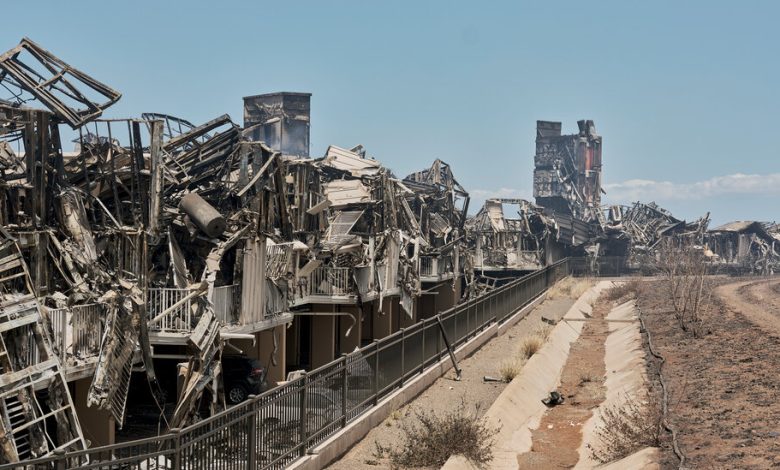Latest About the Maui Wildfires: Emergency Management Chief Resigns

The latest:
-
The chief of the Maui Emergency Management Agency has resigned, effective immediately, the mayor’s office announced on Thursday. The sudden departure comes a day after the chief, Herman Andaya, defended not using outdoor alert sirens during the wildfires.
-
Mr. Andaya cited health reasons as reason for his departure, the mayor’s statement said. “Given the gravity of the crisis we are facing, my team and I will be placing someone in this key position as quickly as possible and I look forward to making that announcement soon,” Mayor Richard Bissen said.
-
The official death toll has reached 111 people and is expected to climb. So far, Maui County has publicly identified only five of the individuals, all of whom were over the age of 70. Children are believed to be among the dead, according to the Maui County police chief, but their names have not been released and may not have been determined yet.
-
The painstaking search for human remains through a burn area of ash and debris in Lahaina will probably continue for at least another week. At least 40 percent of the area had been scoured as of Thursday morning.
Officials are coming under increasing scrutiny for how they handled the crisis on Maui, where a brush fire near the historic town of Lahaina exploded on Aug. 8 into the country’s deadliest wildfire in more than 100 years. Some people who were in the area said they were unaware that their lives were in danger until they saw the fast-moving flames bearing down on them.
Maui emergency officials did not use a system of 80 outdoor alert sirens to warn residents and tourists, and many people said that they did not receive cellphone alerts telling them to evacuate. By the time they realized they had to flee, the main highway connecting the town with the rest of the island was choked with traffic.
A day before Mr. Andaya resigned, he defended his agency’s decision not to use the sirens on the afternoon of Aug. 8. He said on Wednesday that the outdoor alert system along the coastline has been used to direct people toward the hills to escape a tsunami, and that he feared that sounding the sirens this time would send many residents heading toward the flames.
With very little time to leave, some people never escaped their homes, and others died in their cars as they tried to flee. A number of desperate residents felt their best option was to jump into the ocean, where they clung to rocks and huddled together, trying to avoid sparks that streamed off burning buildings and not to breathe in the noxious smoke.
If the first identifications of dead victims are an indication, the town’s older residents were at particular risk. Four of the five victims who have been publicly identified by officials were in their 70s; the fifth was 90 years old.
“Did mistakes happen? Absolutely,” Gov. Josh Green said of the official response at a news conference on Wednesday.
He said he ordered the state attorney general to begin a civil inquiry into the response, and defended the decision not to sound sirens. “The most important thing we can do at this point is to learn how to keep ourselves safer going forward,” he said.
The death toll seems certain to keep rising.
The toll of at least 111 deaths makes the fires on Maui one of the worst natural disasters in Hawaii’s history, and the nation’s deadliest wildfires since 1918, when blazes in northeast Minnesota killed hundreds of people.
Mr. Green has cautioned that the official death toll could go up significantly. “Over the course of the next 10 days, this number could double,” he said in an interview Monday with CNN when the death toll was 99.
Officials began announcing names of the dead on Tuesday.
Dozens of people have also been injured, some critically.
The slow pace of identifying victims has been dictated, officials said, by the large-scale destruction and by Maui’s remoteness, which complicated the arrival of out-of-state search dog teams. As of Thursday morning, the teams had searched about 45 percent of the disaster zone.
Help feels out of reach for many survivors.
Days after the disaster, frustrated residents in West Maui said that they were receiving far more help from an ad hoc network of volunteers, some ferrying supplies in their own boats, than they were from the government.
After the fire devastated Lahaina, a group that includes evacuees and nearby residents remained cut off from power and internet service. Some evacuees slept in parks; others stayed in their own homes that had survived the disaster or with friends in the wider community of that part of the island.
County and federal aid efforts have gathered pace over the past few days. FEMA has made nearly $2 million in payments to about 1,200 survivors as of Tuesday, an agency official said. About 3,400 people have applied for assistance, said Keith Turi, the deputy associate administrator for response and recovery.
Questions are also mounting about the failure of many warning sirens to operate and about fire hydrants that ran dry, raising worries that more people could have been saved with a better emergency response.
What caused the fires?
No single cause has been determined, but experts said one possibility was that active power lines that fell in high winds had ignited a wildfire that ultimately consumed Lahaina.
Brush fires were already burning on Maui and the island of Hawaii on Aug. 8. Maui County officials informed residents that morning that a small brush fire in Lahaina had been completely contained, but they then issued an alert several hours later that described “an afternoon flare-up” that forced evacuations.
The fires on the islands were stoked by a combination of low humidity and strong mountain winds, brought by Hurricane Dora, a Category 4 storm hundreds of miles to the south in the Pacific Ocean.
Worsening drought conditions in recent weeks probably also contributed. Nearly 16 percent of Maui County was in a severe drought a week ago, according to the U.S. Drought Monitor.
Law firms have begun filing lawsuits on behalf of victims, claiming that Hawaiian Electric, the state’s largest utility and the parent company of the power provider on Maui, is at fault for having power equipment that could not withstand heavy winds and keeping power lines electrified despite warnings of high winds.
At a news conference on Monday, Shelee Kimura, the chief executive of Hawaiian Electric, said the company did not have a shut-off program and contended that cutting the power could have created problems for people using medical equipment that runs on electricity. She also said turning off the power would have required coordination with emergency workers.
What’s next?
There are widespread fears that rebuilding will be difficult or impossible for many residents. State and local officials on Monday said that they would consider a moratorium on sales of damaged or destroyed properties, to prevent outsiders from taking advantage of the tragedy.
And the Hawaii Tourism Authority said visitors planning to travel to West Maui within the next several months should delay their trips or find another destination. Most of the 1,000 rooms in the area have been set aside for evacuees and rescue workers.
The hit to the tourism industry presents a major challenge to rebuilding the island’s economy.
A longer-term worry is the changing climate.
The area burned by wildfires in Hawaii each year has quadrupled in recent decades. Invasive grasses that leave the islands increasingly susceptible to wildfires and climate change have worsened dry and hot conditions in the state, allowing wildfires to spread more quickly, climatologists say.

Mapping the Damage From the Maui Wildfires
Fires tore through Maui and leveled entire neighborhoods.
Tim Arango, Kellen Browning and Eileen Sullivan contributed reporting.




